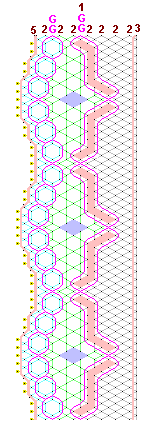


I designed this after doing pattern 568 and pattern 570 to solve some of the problems. The basic problem was the thinness of the cloth strip. In this pattern I introduce an extra pair. for the strip. I also narrow the whole strip by only having a single deiamond in the middle. And I make the edge curved.
Pattern:

Bobbins: 23 pairs + 4 gimps
Style: Bucks Point
Size: 5.5 inches long
Stitches:
half stitch and twist
twist
half stitch
cloth stitch
picot
gimp (pink)
Details:
Bucks Point net (grey)
Kat stitch (green)
twisted hole ground (blue)
cloth footside
picots and passives headside (yellow)
half stitch diamond(blue)
strip(red)
bead(red)
Description:
Follow the links above for explanation of how to work the different parts of the lace.
There is one more pair than might be expected from the grid. This starts at the top of the cloth strips, and stays within them. This bulks out the strips, which are otherwise too narrow. When one strip finishes and another starts, this extra pair puts one thread below the cross-over of gimps and the other above, with twists to make this secure.
The edge is cuved. It has a line of twisted hole ground between the cloth stitch at the edge, and the beads. This reduces the amount of things happening in the same place (gimps, cloth stitch, picots). The curvature is quite pronounced. The cloth stitch varies from two passives to four passives. To reduce the bulkiness, if there are more than two passives, only the first pair and the last are worked in cloth stitch. For the middle pair/s, the worker pair has one thread going above all the passive threads, and the other below, treating them rather like a gimp.

Close up of the lace, so you can see the working in more detail
© Jo Edkins 2025 - return to lace index